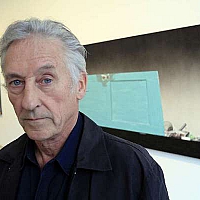
Expositions du 12/05/2006 au 17/06/2006 Terminé
ArteF Fine Art Photography Gallery Splügenstrasse 11 8002 Zürich Suisse
Ed Ruscha Photographs
"I have eliminated all text from my books - I want absolutely neutral material. My pictures are not that interesting, nor the subject matter. They are simply a collection of "facts"; my book is more like a collection of ready-mades."
Ed Ruscha in an interview with John Coplans (printed in Artforum, February 1965)
The work of the Los Angeles-based artist Ed Ruscha, recognised as the embodiment of West Coast Pop, has not yet been grasped in its full significance. His unique portfolio stands like a monolith in America's contemporary art scene and flits between folk, conceptual and Pop Art, in the tradition of Edward Hopper's melancholia, Marcel Duchamp's readymades and James Deans "laconic smart looks".
The ArteF Gallery exhibits photographs created between 1961 and 2001 in the form of 17 artist's books. "I am a painter, who also photographs a bit." In contrast to his well-known, strongly graphic works, with inserted and often suspended text, Ed Ruscha uses his camera to open up a universe of seemingly banal and stereotypical facades of car lots, roofs, gas stations and swimming pools, in the tradition of Dadaism, constructivism and surrealism. Like Eugéne Atget or Robert Frank before him, Ruscha roamed the side-streets of the everyday searching for the awareness of real life as portrayed in Jack Kerouac's novel On the Road.
"I take things as I find them. A lot of these things come from the noise of everyday life." In his photographic cycles, Ed Ruscha expands and exaggerates the concept of readymades (of "found" works of art, which themselves contain no artistic intervention). They are "readyfound" pictures - pictures which hide no cryptic messages or intellectual meanings. On the first viewing the little photo book's seemingly cheap presentation stands out: the pictures are rough snapshots, documentations of shabbiness, and take the place of everyday, grey pictures and words. Together with his idols, Warhol, Jones and Rauschenberg, this Magritte of the American highway was one of the first to throw an openly democratic look at the everyday, and through Pop Art, to view art no longer as something pregnant with meaning and idealized, but rather to introduce naturalness and neutrality (i.e. an absence of interpretations) into photography. "I can't even look at it as photography, they're just images to fill a book. The presentation is as "neuter gender" as possible." With this quasi-documentary way of viewing the everyday, he has become a forerunner and a revolutionary for a younger generation of artists (e.g. Thomas Ruff, Andreas Gursky and Thomas Struth to name a few).
In the photographs, the industrial complexes, built in America after the Second World War, stand for anonymity: the rejection of the aesthetic construction of a "Julius Shulman Hollywood Way of Life." Mass production required faceless, functional buildings and vast parking lots, anonymous highways and modern gas stations. These buildings continue to dominate the face of California's cityscape today. Like dinosaurs these complexes now remain, since the industry has dwindled and/or moved abroad. Nevertheless, one of Ruscha's most famous early pictures bears the ironic title: Los Angeles County Museum on fire. The photography of Ed Ruscha highlights, in a visionary manner, the corrosion of Pax Americana and the often desolate conditions of modern America.ArteF Fine Art Photography Gallery Splügenstrasse 11 8002 Zürich Suisse

